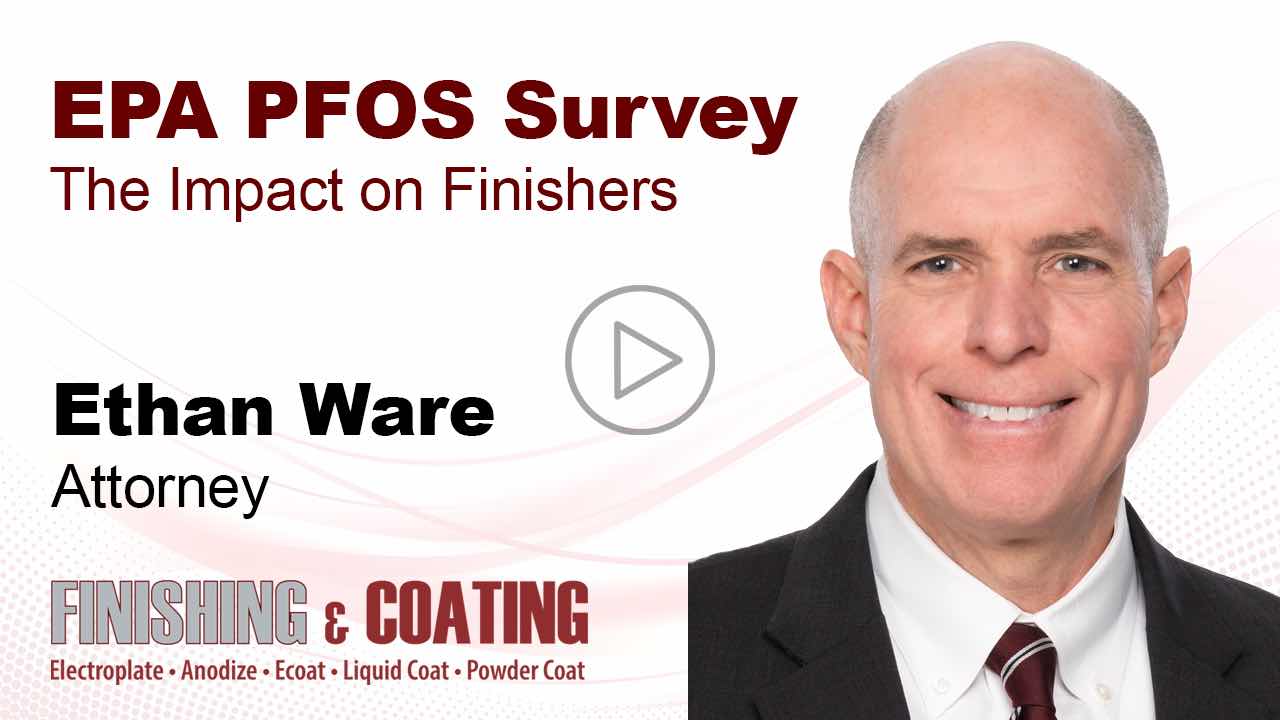The U.S. Environmental Protection Agency will be sending a PFAS questionnaire to electroplaters to collect data for the agency’s planned revision of the metal finishing and electroplating guidelines.
Attorney Ethan Ware is one of the foremost experts on environmental law and has sound advice for any of the 1,815 shops in the U.S. that the EPA will send the survey to determine their effluent discharge for per- and poly-fluoroalkyl substances (PFAS). FinishingAndCoating.com Editor-in-Chief Tim Pennington spoke with Ware about what shops should do to prepare for the survey's arrival.
“Under the Clean Water Act, there is no question that the EPA is trying to do their job,” says Ware, chair of the Environment and Natural Resources Group at Williams Mullen in Columbia, South Caroline, who represents clients in a broad range of matters involving environmental issues.
“The problem seems to be that — rather than limiting it in scope to the objectives of the Clean Water Act and to the way the regulations are typically developed — the EPA seems to have gone beyond that now,” Ware says.
84-Question Survey Takes Deep Dive
The 84-question survey the EPA plans to use — called “Information Collection Request for the Metal Finishing and Electroplating Industry” — is broken into nine specific parts:
- Section 1: General Facility Information
- Section 2: Facility Operations and Per- and Polyfluoroalkyl Substances (PFAS) Use
- Section 3: Wastewater Generation
- Section 4: Wastewater Flow Diagram
- Section 5: Wastewater Management and Treatment
- Section 6: Permit Requirements and Monitoring Data
- Section 7: Environmental and Other Information
- Section 8: Financial Information
- Section 9: Comments
When the survey is approved and sent to finishers, they will have 60 days to complete the questionnaire.
Ware says that finishers should take great care in filling out the survey because of the ramifications if information sent to the EPA is incorrect.
“Under the Clean Water Act, the recipient is going to be asked to sign a certification that the information they provide is accurate, that it has been investigated, and has been honestly answered,” Ware says. “It is a felony not to answer accurately and consistently with the facts as you understand at your business. They have to be 100% candid and honest. And failure to do so can be a liability or a risk for the company.”
EPA Addressing PFAS Discharge
The EPA says the rulemaking is to address PFAS discharges from a subset of facilities in the metal finishing and electroplating point source categories.
“Based on information and data collected during the Multi-Industry PFAS Study, EPA determined PFAS are used by some metal finishing and electroplating facilities to control hexavalent chromium emissions, a known human carcinogen, and inhalation hazard,” the agency says. “EPA determined facilities performing certain chromium operations — including chromium plating, chromium anodizing, chromic acid etching, and chromate conversion coating operations — are the predominant sources of PFAS discharges by the Metal Finishing and Electroplating point source categories.”
Some finishers who claim they have never used PFAS or PFOS in the finishing operation have later found that parts they are getting from their customers contain PFAS or PFOS on the surface from cutting fluids, release agents, or other contaminants that occurred during the manufacturing process.
Ware emphasizes that finishers getting the questionnaire start preparing now and that they should understand what parts that they have brought into the facility may contain, as well as understand what chemicals or coatings they might have or have used on those parts.
The EPA is asking for data from shops going back numerous years to determine the answers it wants on the questionnaire. Ware says the scope is quite large for this survey.
“I will tell you that there is certainly going to be a request if you have even non-reportable data that references PFAS or any of its components,” Ware says. “The questionnaire asks that it be produced and that it be attached to the response and be provided to the EPA.”
Contact attorney Ethan Ware at https://www.williamsmullen.com




































